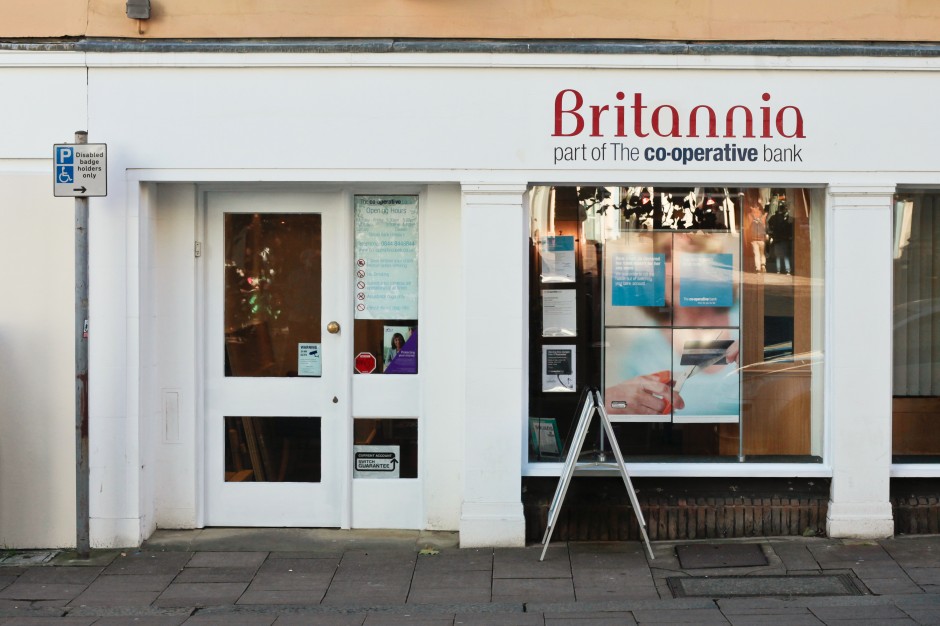The root causes of the Co-operative Bank crisis, which exposed a £1.5bn capital hole, have been uncovered by an independent review.
Sir Christopher Kelly, appointed by the Co-operative Group, has unearthed the factors that were mainly within the control of both organisations. Only two factors outside of the Co-operative Group’s or Bank’s control contributed to the capital shortfall of £1.5bn: the economic environment and the increasing capital requirements imposed on banks in general following the financial crisis.
But the ones within the control of management and the board were: the merger with the Britannia Building Society in 2009; a failure by the Bank after the merger to plan and manage capital adequately; a fundamental weaknesses in the governance and management of risk; material capability gaps, leading to a serious mismatch between aspirations and ability to deliver; past mis-selling of payment protection insurance (PPI); a flawed culture; and a system of governance which led to serious failures of oversight.
In the words of Sir Christopher Kelly, this is a summary of the nine problems that faced the Co-operative Bank and Group.
1. The Economy
The Co-operative Bank was not adversely affected when the wholesale markets dried up during the 2008 financial crisis. But like other banks and building societies it has been affected by the prolonged ensuing period of low interest rates, which has depressed net interest margins and profitability. Because of the mutual status of its parent, retained earnings were a particularly important potential source of additional capital.
2. The Regulator
The financial crisis prompted the Financial Services Authority to require all banks to increase the quantity and quality of their capital. Between 2009, immediately after the Co-operative Bank’s merger with Britannia, and January 2013 the Regulator increased the Bank’s total capital requirement from £1.9bn to £3.4bn. Most of the increase came towards the end of the period.
The timing was particularly damaging. It coincided with a reduction in the Bank’s capital resources caused by the recognition of significant impairments on its commercial real estate lending and against its failed IT replatforming project, as well as significant provisions required to remedy the mis-selling of PPI. It was the interaction between an increased requirement and a reduction in the capital available to meet it that led to the Bank’s capital shortfall.
3. The Merger
The merger of the Co-operative Bank with the Britannia Building Society in August 2009 was a major source of the Bank’s subsequent difficulties. At the time, the Co-operative Bank was a small, full-service bank with a high cost/income ratio, which led to modest profits.
The Bank had long been concerned about its lack of scale and high cost base. The merger allowed it to increase its branch footprint at nil cost. It was also forecast to yield integration savings of £88m a year – a material amount when the Bank’s annual profits in the three years pre-merger had averaged only £67m.
But the merger took place against a background of deteriorating economic conditions and falling asset prices, particularly in commercial real estate. Britannia was not as financially strong as it had been. In its last seven months of independence most of its profits came from a one-off repurchase of some of its subordinated liabilities and debt securities.
The Regulator was sufficiently concerned about Britannia’s position to have placed it on a watchlist. Britannia was not informed of this. In July 2011 the Regulator told the Bank that it believed Britannia would not have survived without the merger.
The Banking Group board was aware of some of the risks. But it believed that management had performed appropriate due diligence and stress-testing and had made a prudent allowance against future impairment of the more risky assets in the form of a Fair Value Adjustment. In practice, though the board does not seem to have been aware of it at the time, the due diligence performed on what turned out to be the most risky part of the acquired assets – the corporate loan book and in particular the commercial real estate lending – had been cursory.
The impact of the merger went wider than the impairments alone. Post-merger, a number of former Britannia executives occupied senior Bank positions. Under alternative management a number of things might have turned out differently. The Bank might, for example, have given greater attention to the option of proactively working out the commercial real estate portfolio had the Bank’s chief executive been looking at the portfolio for the first time rather than having been chief executive of Britannia when the assets were accumulated. Very little attention seems to have been paid post-merger to the fact that the assets were outside the Bank’s risk appetite.
4. The Capital
Management of capital should be a priority for any bank. In 2009 it ought to have been, and probably was, apparent to both executive and board of the Bank that the Bank’s ownership by a mutual meant that it could not access the equity markets. Its small scale meant that it would continue to have difficulty in generating additional capital internally through retained earnings, particularly in a low interest rate environment. Its small capital base meant that it would be less resilient than some others to significant shocks, including self-inflicted ones such as the major impairment charges from its failed replatforming. The Regulator would be imposing increased capital requirements and was likely to continue to do so.
In these circumstances it might have been expected that the executive and board would put particular emphasis on capital, and manage it prudently. One of their most serious failures is that they did not do so. Capital forecasting and planning were poor. The Banking Group did embark on the sale of its life insurance business, a poorly-performing asset. But a significant part of a number of other capital actions which were taken had the deliberate effect of pushing issues into the future – presumably in the hope that profitability would have improved by then.
It is not clear that the Bank board was as well informed as it might have been about the extent to which this was happening. The executive appear consistently to have placed more emphasis on meeting budgets than on the prudent conservation of capital.
5. The Risk
A second important priority for a bank is the management of risk. There were serious failures here too. It is now standard practice for banks to establish three lines of defence to manage risk within a predetermined risk appetite. The Bank had weaknesses in all three lines. It only belatedly started to address them in early 2012, after repeated warnings from the Regulator and after a change in chief executive and chief risk officer.
In the first line, the business banking relationship managers showed inadequate risk awareness. The second line, which is supposed to provide independent challenge to the business and unbiased reports to the board, was poorly organised and insufficiently resourced. The quality and focus of the third line – Internal Audit – was also deficient.
It is difficult to assess whether better management of credit risk would have led to any material difference in the eventual capital shortfall. It ought to have led to more effective control of the Co-operative Bank’s heritage lending and a more robust management of the inherited commercial real estate lending. But with markets as they were at the time it might simply have crystallised and brought forward greater losses than if the assets had been held to maturity. On the other hand, it is also possible that earlier recognition of the riskiness of its inherited portfolio would have forced the Bank to face up to the implications at an earlier stage, before its capital requirement was increased so substantially. It might also have caused the Bank to think more carefully about some of the other things it was doing.
6. The Capability
The Britannia merger did little to increase the capability of the Bank. There were talented people in the merged Bank. But some of the senior team lacked appropriate experience. The incoming chief executive, Neville Richardson, had not worked in a bank before. The chief risk officer was an actuary not a banker. The ex-Britannia executive given responsibility for the post-merger integration and the IT replatforming had managed the integration of the Bristol & West Building Society into Britannia some years previously. But he had not overseen a change programme of the complexity he now faced. Responsibility for strategy was given to the director of organisational development, whose main role was HR.
The Bank appeared to be largely unaware of the limitations on its own capability and what that meant for its capacity to deliver major programmes. A more self-aware executive and board might have reconsidered the replatforming programme once it had been complicated by the merger. They might also have refrained from pursuing the negotiations with Lloyds Banking Group about acquiring significant additional assets when both the replatforming programme and the integration of Britannia were far from complete.
Management stretch was a particularly acute issue for the Bank from 2011 onwards when it started the negotiations with Lloyds Banking Group and began Project Unity. The protracted negotiations over Verde were a major distraction for senior executives of the Bank. Without the distraction caused by Verde the emerging capital issue might have been better recognised and more effectively addressed at an earlier stage. Unity’s stated objectives were largely unexceptional – to save costs by amalgamating various common services across the Co-operative Group and, in time, to increase cross-sales.
But the project was clumsily implemented in a way that implied that the Group chief executive, who was perceived to be its main advocate, and the Group board did not fully understand the requirements of a regulated bank. Project Unity moved staff between Bank and Group and changed reporting lines, which undoubtedly led to some disruption to the risk and internal audit functions at a crucial time.
7. The Mis-selling
The mis-selling of payment protection insurance (PPI) was largely a pre-merger issue, almost entirely related to the Co-operative Bank. Like other banks, the Bank had seen PPI as a highly profitable product to supplement low margins on its other business. Again like other banks, it had made no provision in its accounts for the possibility of compensation payments to its customers prior to May 2011. By the first half of 2013, it had provided for expected mis-selling costs of £269 million – a disappointing outcome for an avowedly ethical bank.
In its 2013 Annual Report and Accounts, the Bank reported a total conduct and legal risk charge for the year of £412 million, which included further provision for PPI as well as for other issues relating to mortgage products and compliance with the Consumer Credit Act.
8. The Culture
The culture of the Bank contributed to the debacle in a number of ways. I have already referred to risk management failings which allowed the pursuit of too many initiatives, given limited management capability.
Damaging aspects of Bank culture included a willingness to accept poor performance; confused or diffused accountabilities in a number of important areas, including risk and change management; a tendency not to welcome challenge; a willingness to accept certain key assertions without subjecting them to proper scrutiny; and a tendency to promote good news and to delay bad news.
Other areas included unwarranted optimism that an economic recovery would raise low levels of profitability and lift the value of property assets; a board and executive which allowed themselves to be carried along by events, rather than stepping back at appropriate points and taking stock; a tendency towards being inward-looking, arguably not helped by being based outside London; a failure to take seriously enough the warnings given by the Regulator or the (not always consistent) advice they received at different times from a series of professional advisers; a willingness to take opportunities to shift problems into the future when it would be more prudent to address them earlier; and less than complete transparency.
9. The Governance
The Group board contributed to what happened in a number of ways.
It failed to ensure that it had a clear perspective on the long-term place of the Banking Group within the Group’s portfolio. At no time did it have a clear strategy for the Bank. It failed to exercise appropriate stewardship of one of the Group’s major assets, particularly during a period of merger and financial crisis – an inevitable consequence of the limited relevant experience of the individual board members.
The Group chief executive was allowed too much latitude in pursuing Project Unity in a way which suggests that neither he nor the board can have fully appreciated the differences between a regulated bank and the trading businesses.
It appointed a chair of the Banking Group – an individual who manifestly did not have the appropriate experience. The Regulator did not object. But it was the Group board’s appointment, not the FSA’s.
It failed to appoint an experienced, permanent Banking Group CEO following the resignation of Neville Richardson in July 2011 and did not ensure that more non-executives on the Co-operative Banking Group board had relevant banking experience.
The board allowed itself to be seduced by the prospects of an apparently bargain price for Verde without giving sufficient thought to its integration or the impact on business as usual; and then compounded that by failing to call a halt earlier.
The Co-operative Banking Group (CBG) board must be regarded as being at least as culpable as the Group board since it had the more direct responsibility. Unlike the Group board, the CBG board did include a small number of independent professional non-executive directors (IPNEDs), some of whom had previous banking experience. But they were in a minority and must have been hampered by the size of the board – 22 members immediately after the Britannia merger – and by the lack of banking experience of the chair.
When failures of this magnitude occur boards must always accept accountability, if only for things they did not do. Looked at with the advantage of hindsight, I am surprised that a board which did possess a small number of experienced and well-regarded individuals nevertheless failed to raise more concerns about the way the Bank was being managed; failed to insist that the shortcomings in the operation of the risk management framework were addressed; failed to require a much greater emphasis on capital; failed to hold the replatforming project sufficiently to account as cost escalated and timescales slipped; and failed to call a halt to the Verde negotiations, despite the doubts many of the board members appear to have had about it, and even though one deputy chair told the review he resigned over the issue and the other told the Review he tried to resign – though he was initially persuaded not to.








